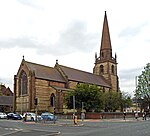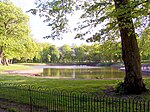Tue Brook railway station
Disused railway stations in LiverpoolFormer London and North Western Railway stationsMerseyside railway station stubsPages with no open date in Infobox stationRailway stations in Great Britain closed in 1948 ... and 2 more
Railway stations in Great Britain opened in 1870Use British English from August 2017
Tue Brook railway station was located on the north side of West Derby Road, Tuebrook, Liverpool, England, opposite Newsham Park on the Canada Dock Branch.
Excerpt from the Wikipedia article Tue Brook railway station (License: CC BY-SA 3.0, Authors).Tue Brook railway station
West Derby Road, Liverpool Tuebrook
Geographical coordinates (GPS) Address External links Nearby Places Show on map
Geographical coordinates (GPS)
| Latitude | Longitude |
|---|---|
| N 53.4243 ° | E -2.9353 ° |
Address
Tue Brook
West Derby Road
L6 4BN Liverpool, Tuebrook
England, United Kingdom
Open on Google Maps







